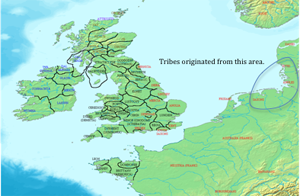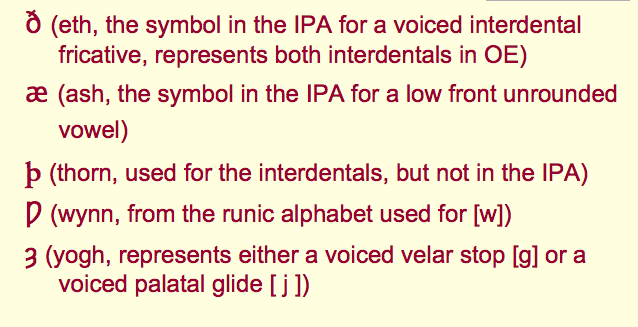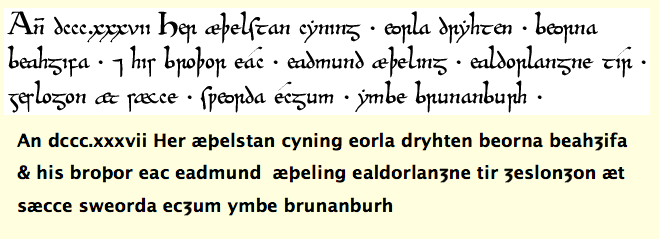|

|
English Structures
Historical Linguistics: The History of English
|
Old English
Old English was the language of the Angles and the Saxons, two Germanic tribes that migrated across Europe to Great Britain, as did a third group, the Jutes. It is also called Anglo-Saxon to reflect the fact that it was used by both of the first two groups. The name Old English maintains the attachment to the Angles, as does the name England (Angleland).
Major works of the Old English period include:
Historical Notes (450 - 1100)
|
|
The Angle, Saxon, and Jute tribes left their homelands in northern Germany, Denmark and northern Holland in the 5th and 6th centuries and crossed the North Sea to Great Britain. Historians are not sure why the Anglo-Saxons came to Britain. Some sources say that Saxon warriors were invited to come to England to fight the Romans, but there may have been other reasons. They may have migrated because their land often flooded and it was difficult to grow crops, so they were looking for new places to settle down and farm.
The Anglo-Saxons took control of most of Britain, although they never conquered Scotland, Wales or Cornwall. They divided the country into kingdoms, each with its own royal family. The stronger kingdoms often took control of the weaker kingdoms.
By around AD 600 the five main Anglo-Saxon kingdoms were Northumbria, Mercia, Wessex, Kent and Anglia.
http://www.bbc.co.uk/schools/anglosaxons/invasion/index.shtml

http://en.wikipedia.org/wiki/Image:Britain_500_CE.png |

http://www.bbc.co.uk/schools/anglosaxons/invasion/index.shtml |
|
Key Features of Old English |
Old English was obviously very different from Modern English, but several key distinctions can be identified. These key features of Old English include:
- A high use of inflectional affixes, such as noun suffixes
- The same basic word order as Modern English but with more flexibility in order due to the use of suffixes.
- A closer match between sounds and written symbols than Modern English.
- Writing system included letters that have since been lost.
|
Inflectional Affixes in Old English
Old English was a synthetic language (synthetic in terms of sticking things together): it relied on inflectional endings (grammatical suffixes) much more than Modern English does. For example, in Modern English we know the subject of a sentence because of its location in the sentence, but in Old English, the subject was marked by an inflectional ending (suffix). Many of the suffixes from Old English have since been lost.
|
Noun Suffixes in Old English
- Example-Singular: se stan (the stone)
- Nominative (subject) se stan
- Genitive (possessive) ðæs stanes
- Dative (indirect object) ðæm
stane
- Accusative (direct object) ðone stan
- Instrumental (object of prepositions) ðy
stane
|
- Example-Plural: ða stanas (the stones)
- Nominative (subject) ða stanas
- Genitive (possessive) ðara stana
- Dative (indirect object) ðæm
stanum
- Accusative (direct object) ða stanas
- Instrumental (object of prepositions) ðæm
stanum
|
Remaining Suffixes in Modern English
Modern English has only three remaining inflectional endings for nouns:
- Plural –s (nominative, dative, accusative, instrumental) the
stones
- Possessive –’s (genitive singular) the
stone’s
- Plural Possessive –s’ (genitive plural) the
stones’
|
The loss of affixes was probably due to phonetic changes.
The final sound segments were probably reduced and finally deleted. |
|
Word Order Changes
Every language has a preferred word order for its major grammatical relations: Subject, Verb, direct Object.
There are six possible word orders:
- SOV (German)
- SVO (English, all versions)
- VSO
- VOS
- OVS
- OSV
Synthetic languages allow greater flexibility in word order, even though they have a preferred order, than do analytic languages. This is because the role of any word in a synthetic language can be seen by its suffixes. Old English used a lot of suffixes, so although it had a preferred word order of S-V-O, it didn't have to stick to this order very strictly. Old English shares this preference for S-V-O word order with Modern English.
As English began to lose its affixes, however, it changed from being a synthetic language to being an analytic language. That is, English changed from relying on inflectional affixes for grammatical meaning to relying on word order and functional words for grammatical meaning. In short, we can say that English gained rigidity in syntactic word order as a way to show the role of each word in a sentence and lost its flexibility because it lost too many affixes.
|
Writing in Old English
Old English was written with a greater phonetic relationship between
its sounds and symbols. As the language changed, the written form also
changed, and we have lost some of the symbols.
The table below identifies some of these lost letters.

|
|
Activity: Seeing Lost Letters
Here is a sample of an Old English Manuscript that allows you to see some of the lost letters. Begin with the image of an actual Old English manuscript and see if you can identify any of the lost letters as well as some of the letters we stiull use. For help, a modern font transcription has been provided for you below the original.

|
|
Highly Phonetic Alphabet
If you try reading the manuscript sample out loud, you need to know that every letter is pronounced in every word. For a pronounciation guide, try the University
of Calgary Old English site.
Reading the sample will not only give you an idea of how much this language has changed, but will be a reasonable inpression of how a NNS speaker with some English ability, but still a beginning level, may percieve what they are doing. |
|
| Part 3 |
|
American Sign Language The sign language used by the deaf community in the United States.
Test of English for International Communication. A standardized exam for Educational Testing Services that is intended to determine the general capability of an NNSE to use English to conduct business. It is used by some businesses, predominantly in Asia, in hiring.
Test of English as a Foreign Language. A standardized exam from Educational Testing Services that is intended to determine the general capability of an NNSE to use English as the language of insruction .It is used as an admissions requirement by most US universities and colleges for international students.
Teaching English to Speakers of Other Languages. A term that encompasses both TEFL and TESL. It is the name of the professional organization to which many teachers belong. TESOL the organization has many regional affiliates both in the US and abroad.
Teaching English as Second Language. Refers to the activity of teaching the English language as a tool necessary for some daily task like instruction, shopping, or interpersonal interactions.
Teaching English as a Foreign Language. Refers to the activity of teaching the English language as an intellectual, academic pursuit to non-native speakers of English.
Native Speaker of English. Refers to a person who acquired English in infancy and young childhood as a first language.
Native Speaker. Refers to a person whose relationship to a language is that it was encountered in infancy and young childhood as the dominant language of the environment.
Non-Native Speaker of English. Refers to a person who didn't acquire English as a first language, but came to it after another language was established.
Non-Native Speaker. Refers to a person whose relationship to a particular language is that he/she didn't encounter it while initially acquiring language, but came to it after another language was established.
Limited English Proficient. An adjectival phrase used to refer to the same students as ELL refers to. LEP is falling into disuse as it focuses attention on student deficiency rather than on the positive attribute of learning. Is being replaced by ELL.
Second Language. Refers to any language gained subsequent to the first or native language. It is acquired or learned secondarily to the native language. Doesn't refer to the ordinal numbering of languages, only to the relationship of a particular language to a persons native language.
First Language. Refers to the language that an individual encounters as an infant and young child; a persons native language.
English for Specific Purposes. Refers to the goal of learning English to use it for highly focused activity, such as for business or for aviation communication.
English as a Second Language Program. refers to a school program that is purposefully structured to provide instruction on the English language to NNSEs. An ESL program does not typically include instruction in any other subjects than English. An ESL program may be a component of a larger ELL program at a school.
English as a Second Language. Refers to the subject matter of the English language and the methodology for teaching the English language to non-native speakers. ESL makes no reference to the subjects other than English, but it is not methodology alone either, it refers to teaching the English language as content area. Typically, ESL refers to the study of English in a country where it is used for at least one daily task, such as instruction, interpersonal relations, or shopping.
English Langauge Learner Program. Refers to a school program that is purposly structured to provide instruction on the English language and instruction in other content areas to English Language Learners.
English Language Learner. Refers to students who are in the process of learning English, whether they are in ESL classes exclusively or a combination of ESL classes and other subject area classes.
English as a Foreign Langauge. Refers to the study of English as an intellectual, academic pursuit, not a a language whose use is necessary or desirable for daily life, although it may be used as a research tool. Typically, EFL is the study of English in a country where English is not a language of instruction or daily interactions, such as in Italy or in Saudi Arabia.
English for Academic Purposes. Refers to the goal of learning English to use it as the language of instruction for other subject areas.
Refers to a school program that is purposely structured so that students will use two languages on a daily basis.
Refers to the use of two languages in any capacity on a daily basis. A bilingual person uses two languages on a daily basis--for work and at home, perhaps, or for different subjects at school. Can also refer to the ability to use two languages, even if not used daily.



